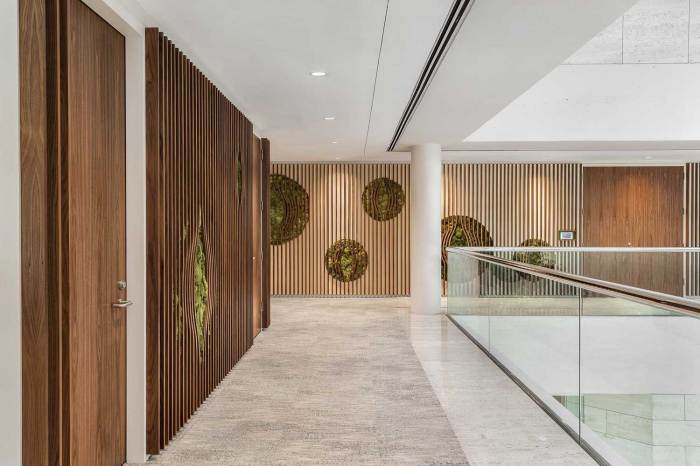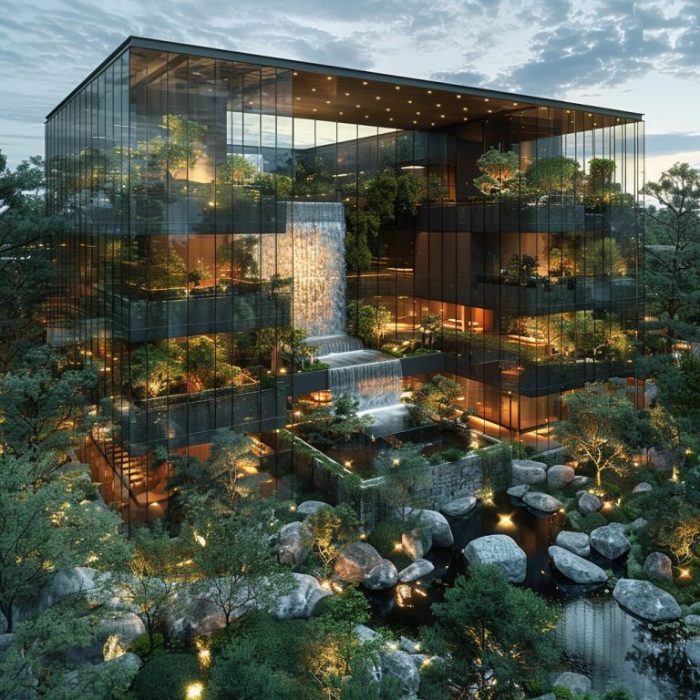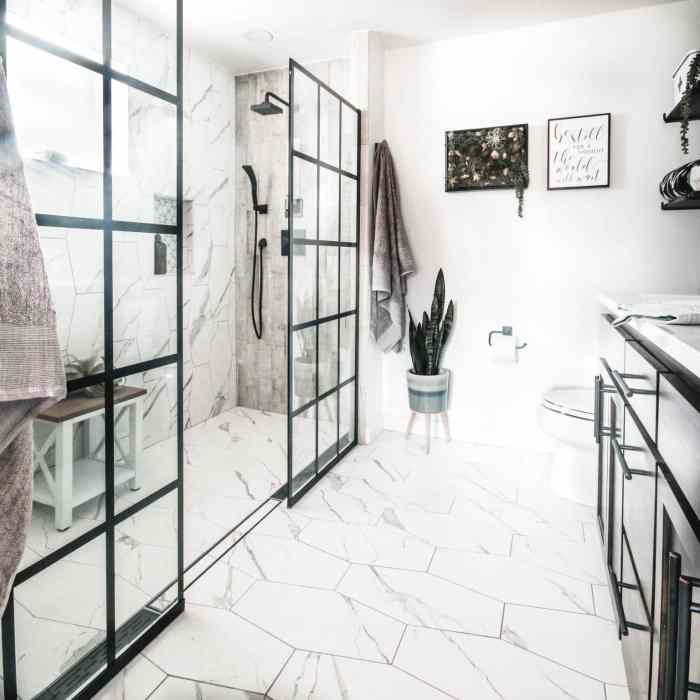Office Waterfall Wall A Modern Oasis
Office waterfall wall designs are transforming modern workplaces. These dynamic features aren’t just aesthetically pleasing; they offer a unique blend of visual appeal, acoustic benefits, and functional advantages. From open-plan offices to reception areas, a well-designed waterfall wall can create a calming atmosphere, enhancing both employee well-being and productivity. Understanding the design considerations, material choices, and cost analysis is crucial for successfully integrating these stunning features into any office space.
Defining Office Waterfall Walls

Source: keanyinteriors.com
Office waterfall walls are a contemporary design element that transforms functional spaces into aesthetically pleasing and dynamic environments. They seamlessly integrate design elements with practicality, creating a unique visual focal point and often serving multiple purposes. These features are increasingly popular in modern office layouts, offering a variety of styles and configurations to suit diverse aesthetic preferences and functional needs.
These structures, often featuring cascading water features, are designed to provide visual interest, enhance acoustics, and even contribute to improved air quality through controlled water vapor. They are more than just decorative pieces; their integration into office design fosters a sense of calm, stimulates creativity, and can significantly impact employee well-being.
Types of Waterfall Walls
Waterfall walls come in various styles, each with distinct characteristics. Some walls might feature a single, continuous cascade, while others might incorporate multiple tiers or levels for a more complex visual effect. The design can range from a minimalist, modern aesthetic to a more elaborate, dramatic presentation, adapting to the specific design theme of the office.
Materials Used in Waterfall Walls
A wide array of materials are employed in constructing office waterfall walls. Common choices include natural stone, such as granite or marble, for their durability and inherent beauty. Manufactured stone, composite materials, and even glass can also be used, providing a broader spectrum of design options and price points. The selection of materials influences the overall aesthetic appeal and the practicality of the wall, considering factors like water resistance and ease of maintenance.
Materials and Aesthetics
The material selection for waterfall walls has a direct impact on the overall aesthetics. Natural stone, for example, lends a classic, timeless look, while composite materials offer a greater range of colors and textures. The color palette and surface finish contribute significantly to the overall ambiance of the space. For example, a wall featuring a light gray granite might create a serene and modern atmosphere, while a darker stone might evoke a more dramatic and sophisticated feel.
Functional Considerations
Waterfall walls are not merely decorative; they can serve multiple functions within an office environment. Their incorporation into open-plan offices can help define work zones, creating a sense of privacy without physical barriers. In reception areas, they can act as a stunning focal point, welcoming visitors and enhancing the first impression of the company. Collaborative spaces can benefit from the calming and inspiring ambiance they provide. The precise placement and design of the wall within a particular space can significantly affect its functionality and impact.
Suitable Office Environments
Waterfall walls are suitable for a range of office environments, each leveraging the features to achieve specific design goals. Their visual appeal makes them ideal for reception areas, creating a welcoming and memorable first impression. In open-plan offices, they can serve as visual dividers and acoustic barriers, fostering a more productive and focused environment. The aesthetic impact of waterfall walls makes them an excellent addition to collaborative spaces, promoting a sense of calm and creativity.
Design Considerations for Waterfall Walls
Integrating a waterfall wall into an office design presents unique opportunities to enhance the workspace environment. Careful planning and consideration of various factors are crucial to maximize the aesthetic and functional benefits of this feature. Beyond the obvious visual appeal, thoughtful design can significantly improve the overall atmosphere and productivity of the office.
A well-designed waterfall wall can significantly transform a space, from a simple breakroom to a dynamic executive suite. The impact extends beyond the immediate visual presence, influencing the overall ambiance and fostering a more engaging and inspiring work environment. Understanding the crucial design considerations ensures the waterfall wall serves its purpose effectively.
Space Planning and Integration
Proper space planning is paramount when incorporating a waterfall wall. The wall’s size and placement must align with the overall office layout, ensuring it doesn’t obstruct workflow or crucial areas. Careful measurement and consideration of traffic flow, furniture arrangements, and the placement of other essential elements like meeting rooms and workstations are vital. Integrating the waterfall wall into the existing space should not feel intrusive but rather seamlessly integrated. For example, a large, open-plan office would benefit from a central waterfall wall to define areas or create a focal point, while a smaller, more compact office might use a smaller, more discreet wall to avoid overwhelming the space.
Visual Impact and Ambiance
Waterfall walls create a powerful visual impact. The cascading water evokes a sense of serenity and tranquility, potentially reducing stress and promoting relaxation. The natural element can serve as a captivating focal point, drawing attention and inspiring creativity. Furthermore, the sound of the water adds a soothing ambiance, enhancing the overall atmosphere of the space.
Color, Texture, and Lighting Schemes, Office waterfall wall
The choice of color, texture, and lighting scheme significantly influences the overall aesthetic of the waterfall wall. Light, neutral colors like beige, gray, or white can create a calming and sophisticated atmosphere, while bolder colors can add vibrancy and energy. Textures, such as smooth stone or polished metal, can complement the water’s flow and enhance the overall design. Consider the interplay of natural light, artificial lighting, and the colors of the surrounding environment. For example, a wall featuring a dark gray stone backdrop with cool-toned lighting could create a modern and sophisticated ambiance, whereas a light beige backdrop with warm lighting might create a more serene and inviting atmosphere.
Lighting Selection
Proper lighting is essential to highlight the waterfall wall’s beauty. Ambient lighting, such as recessed lighting or track lighting, can illuminate the surrounding area and create a balanced atmosphere. Accent lighting, strategically positioned to illuminate the waterfall itself, can highlight the cascading water and create a mesmerizing visual effect. Consider the time of day and the desired mood. For example, soft, warm lighting during the evening hours can create a romantic and relaxing ambiance, whereas brighter, cool lighting during the day can enhance the waterfall’s visual appeal.
Acoustic Considerations
Acoustics play a vital role in an office environment, particularly when incorporating a waterfall wall. The sound of running water can help to mask distracting noises and create a more focused atmosphere. However, the sound of the waterfall must be balanced to avoid being overwhelming. Incorporating sound-absorbing materials, such as carpets or acoustic panels, can effectively reduce echoes and reverberations, enhancing the overall acoustic quality of the space.
Integrating with Décor and Brand Identity
The design of the waterfall wall should seamlessly integrate with the existing office décor and brand identity. The choice of materials, colors, and lighting should reflect the overall aesthetic of the office and resonate with the company’s brand values. For example, a tech company might opt for a modern, sleek design with cool-toned lighting, while a creative agency might incorporate more vibrant colors and textures to reflect their brand’s personality. Careful consideration of these factors ensures that the waterfall wall complements the existing design and enhances the office’s overall aesthetic.
Functionality and Practicality of Waterfall Walls
Waterfall walls, with their captivating aesthetic, offer more than just a visually appealing addition to an office space. Their functionality extends to fostering a sense of calm, boosting productivity, and creating a more ergonomic and efficient work environment. Careful design considerations are key to realizing these benefits.
Integrating waterfall walls into an office design can contribute to a calming and focused atmosphere. The gentle sound of flowing water, often associated with relaxation and tranquility, can help reduce stress and promote a more serene work environment. This can be especially beneficial in open-plan offices where noise levels can be higher.
Impact on Productivity and Employee Well-being
Waterfall walls can significantly impact office productivity and employee well-being. The soothing ambiance created by the flowing water can lead to reduced stress levels and improved concentration. This, in turn, can contribute to enhanced focus and efficiency. Employees feeling less stressed tend to be more productive, leading to increased output and a more positive work environment. Moreover, the visual interest and aesthetic appeal of the waterfall wall can elevate the overall atmosphere of the workspace, promoting a sense of well-being and encouraging engagement.
Ergonomic Considerations
Careful consideration of ergonomics is essential when integrating waterfall walls into an office layout. Placement should account for natural light, ensuring adequate visibility and minimizing glare. The height and design of the wall should be appropriate for the office space and the needs of the employees, taking into account potential obstructions or obstacles for movement. Consideration of the potential for sound reflections from the wall and the potential for disruptions from the water flow should be factored into the design. This involves optimizing the flow rate and adjusting the placement of the wall to minimize these disruptions.
Integration of Technology and Storage
Integrating technology and storage solutions into the design of waterfall walls presents a practical opportunity to maximize space and functionality. Hidden compartments or integrated shelving can be incorporated behind or within the waterfall wall to provide storage for documents, equipment, and other essentials. Embedded lighting or digital displays can be seamlessly integrated into the design, providing additional visual appeal and functionality. The integration of these elements should be carefully planned to ensure both aesthetic appeal and practicality.
Maintenance and Cleaning
Proper maintenance and cleaning are essential for the longevity and aesthetic appeal of waterfall walls. The specific materials used in the construction of the wall will dictate the appropriate cleaning methods. Regular cleaning with mild detergents and soft cloths will help maintain the pristine appearance of the waterfall. The type of water filtration system used will influence the frequency of cleaning and maintenance required for the wall. This should be part of the initial planning and design.
Suitable Office Spaces
| Office Space | Advantages |
|---|---|
| Open-plan office | Improved visual separation, sound absorption, creating focused zones. |
| Reception area | Aesthetic appeal, brand enhancement, welcoming atmosphere. |
| Collaborative space | Visual focal point, encouraging interaction, while providing a calming element. |
Budget and Cost Analysis

Source: dreamimaginations.com
Budgeting for a captivating office waterfall wall requires careful consideration of various factors. The cost can vary significantly depending on the scale, complexity, and materials chosen. Understanding the different pricing models and potential cost-saving strategies is crucial for staying within budget while achieving the desired aesthetic and functionality.
The cost of a waterfall wall installation isn’t solely determined by the material; labor, design, and logistical factors also play a vital role. A detailed analysis of these elements is essential to create a realistic budget.
Pricing Models for Waterfall Walls
Different pricing models exist for waterfall wall installations. These typically include material costs, labor costs, and design fees. Material costs are directly influenced by the chosen material’s rarity, quality, and quantity. Labor costs vary based on the complexity of the installation, the skill level of the installers, and the duration of the project. Design fees depend on the complexity of the design, the experience of the designer, and the level of customization required.
Material Costs and Examples
The table below provides a general overview of material costs and durability.
| Material | Cost | Durability |
|---|---|---|
| Glass | Medium | High |
| Acrylic | Low | Medium |
| Stone | High | Very High |
Glass, while offering a modern and sleek aesthetic, falls within a medium cost range. Acrylic, a more budget-friendly alternative, provides a translucent visual effect, suitable for smaller-scale installations. Natural stone, with its inherent beauty and durability, often commands a higher price point.
Budget-Friendly Design Options
Several design options can significantly impact the budget without compromising the aesthetic appeal of the waterfall wall. Consider a smaller-scale waterfall, opting for a more minimalist design. A reduced number of cascading levels can also lower material costs. Choosing a less expensive material, like acrylic, can be a viable alternative.
Cost-Saving Strategies
Several strategies can be employed to keep costs in check. Negotiating with suppliers and contractors is essential to secure better pricing. Considering pre-fabricated or modular components can streamline the installation process and reduce labor costs. Implementing a more straightforward design with fewer features can minimize the complexity of the project, leading to a lower design fee.
Environmental Considerations

Source: midwest-tropical.com
Sustainable design principles are increasingly important in office construction, and waterfall walls are no exception. Careful consideration of materials and installation methods can significantly reduce the environmental impact of these striking features. The choice of materials, from sourcing to disposal, plays a crucial role in minimizing the overall ecological footprint.
Impact of Materials
The environmental impact of materials varies considerably. Some materials have a smaller carbon footprint than others, impacting the overall sustainability of the waterfall wall project. Factors like the material’s origin, manufacturing process, and potential for recycling or reuse all contribute to its environmental footprint. Understanding these differences is crucial for responsible design choices.
Sustainable Design Choices
Several sustainable design choices can minimize the environmental impact of waterfall walls. Prioritizing recycled or renewable materials is a primary step. These materials often require less energy to produce, reducing greenhouse gas emissions. For instance, using reclaimed wood for supporting structures or recycled glass for the cascading elements significantly lowers the environmental footprint.
Eco-Friendly Installation Practices
Minimizing waste during installation is also key to responsible design. Careful planning, precise cutting, and proper disposal of construction debris are crucial. Using water-efficient systems for the waterfall’s operation further reduces the environmental impact. Implementing these eco-friendly practices demonstrates a commitment to sustainable design.
Environmental Impact Table
| Material | Environmental Impact | Explanation |
|---|---|---|
| Recycled glass | Low | Recycled glass requires significantly less energy to produce than virgin glass, and its use conserves natural resources. The recycling process reduces landfill waste. |
| Bamboo | Medium | Bamboo is a fast-growing renewable resource. Its cultivation requires less water and pesticides than many traditional wood sources. However, transportation distances can impact the overall carbon footprint. |
| Concrete | High | Concrete production is energy-intensive, releasing significant amounts of carbon dioxide. The extraction of raw materials also contributes to environmental damage. Limited recycling options further increase its environmental impact. |
Final Conclusion
In conclusion, office waterfall walls offer a compelling solution for modern office design. They provide a beautiful focal point, contribute to improved acoustics, and potentially boost employee well-being. Careful consideration of space planning, material selection, and budget will ensure a successful integration into any office environment. The various advantages and considerations, from environmental impact to practical maintenance, should be meticulously evaluated before committing to this design choice. Ultimately, a well-implemented office waterfall wall can transform a workspace into a more engaging and productive environment.





